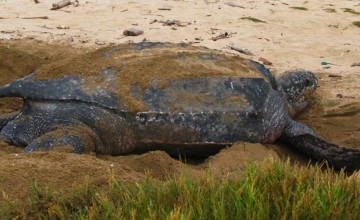
Hector
Guzman
Rapid change and lack of pristine marine environments skew basic research. Instead of studying tropical systems unchanged for millennia, scientists must ask questions about ongoing human impacts and conservation to inform policy.
Projects and Stories
Research Focus
Additional links
Contact
Research Overview
Can we halt degradation and restore marine ecosystems?
"Illuminating the path to marine ecosystem restoration requires knowledge of the marine realm's natural processes and how these have changed. We do this with real-time monitoring of sensitive marine habitats and species populations. The combination of scale and spatial data analysis available now may rapidly inform conservation and policy to halt degradation and start restoring marine ecosystems."
Why are some megafauna species changing their behavior in the tropics?
Some highly migratory orcas are changing their movement patterns, home ranges and habitat use. We don’t know if this is due to climate change, or the collapse of fisheries and the rise of new food sources, such as humpback whale calves, which have increased in number as the whale population recovers. One trend we have documented with photography is that humpback whale flukes have shown a steady increase in bite marks associated with orcas over the last few decades, suggesting that orcas may be increasing attacks on calves as a food source. We’re also looking at reports of possible increases of orca attacks on fish caught by commercial fishers. But to get at these questions we need to start with understanding their basic movement ecology: what are they eating, where are they moving, where they come from, and what are they doing? We need to work on the genetics and morphology of orca subspecies (or potentially separate species) and track whales with satellite technology.
How is marine bird behavior changing in response to fishery collapse?
Marine birds are apex predators and they are facing increasing competition from commercial fishers and the impact of climate change on their food sources. In the Eastern Tropical Pacific, an El Niño event can exacerbate these problems and lead to mass mortality and mass migration of groups of birds numbering in thousands. To address these issues, we need to understand the basic ecology and life histories of these birds. On islands in the ETP, we’re using drone technology to measure colony productivity along with satellite tracking tags to learn how far they must travel to find food sources.
Can we track marine ecosystem degradation and natural restoration by monitoring the soundscape or acoustic changes in habitat and animal populations?
Our preliminary research on coral reef habitats show dramatic changes in the marine soundscape as reefs transition from degraded to healthy. Healthier reefs have notably “better” sound that degraded ones, which tend to produce a dull whining sound. We have also deployed sonar technology to track behavior of manatees in threatened Caribbean populations. We are also deploying instruments to study how commercial ship traffic impacts communication and behavior of humpback whales.
What is the most effective approach for implementing research-based policy: scientific lobbying or sharing burdens with NGOs?
I find that engaging policymakers directly is important since direct communication lines with authorities are important to decision-makers and nongovernmental organization focused on conservation might not necessarily have the ability to influence and inform policy on their own. Our role as scientists is to offer technical advice based on our best scientific research and to act as ambassadors for the importance of research in creating successful conservation policy.
Education
1979 B.Sc. Biology (Marine Biology), University of Costa Rica, Costa Rica.
1986 M.Sc. Biology (Marine Biology), University of Costa Rica, Costa Rica.
1994 Ph.D. Biology, Newcastle University, United Kingdom.
Selected Publications
Guzman, H.M. Beaver, C.E., & Diaz-Ferguson, E. (2021). Novel insights into the genetic population connectivity of transient whale sharks (Rhincodon typus) in Pacific Panama provide crucial data for conservation efforts. Frontiers Marine Science. 8: 744109
Urban J.R., E. Jiménez-López, H.M. Guzman, L. Viloria-Gómora. (2021). Migratory behavior of an eastern North Pacific gray whale from Baja California Sur to Chirikov Basin, Alaska. Frontiers Mar. Sci. 8, 235.
Guzman, H.M., N. Hinojosa & S. Kaiser. (2020). Ship’s compliance with a Traffic Separation Scheme and speed limit in the Gulf of Panama and implications for the risk to humpback whales. Marine Policy. 120: 104113.
Breedy, O. & Guzman, H.M. (2020). A revision of the genus Psammogorgia Verrill, 1868 (Cnidaria: Anthozoa: Octocorallia) in the eastern Pacific. ZooKeys 961:1-30.
Merchan, F., A. Guerra, H.E. Poveda, H.M. Guzman, J.E. Sanchez-Galan. (2020). Bioacoustic Classification of Antillean Manatee Vocalization Spectrograms using Deep Convolutional Neural Networks. Applied Sciences 10(9): 3286.
Guzman, H.M., Capella, J.J., Valladares, C., Gibbons, J., Condit, R. (2020). Humpback whale movements in a narrow and heavily-used shipping passage, Chile. Marine Policy. 118: 103990.
Guzman, H.M., S. Kaiser & E.Weil. (2020). Assessing the long-term effects of a catastrophic oil spill on subtidal coral reef communities off the Caribbean coast of Panama (1985-2017). Marine Records. 50:1-19.
Guzman, H.M., S. Kaiser, V.J. van Hinsberg. (2020). Accumulation of trace elements in leatherback turtle (Dermochelys coriacea) eggs from the south-western Caribbean indicates potential health effects to consumers. Chemosphere 243: 125424.
Guzman, H.M., G. Rogers, C.G. Gomez. (2019). Behavioral states related to environmental conditions and fisheries during olive ridley turtle migration from Pacific Panama. Frontiers Mar. Sci. 6: 770.
Merchan, F., G. Echevers, H. Poveda, J.E. Sanchez-Galan & H.M. Guzman. (2019). Detection and identification of manatee individual vocalizations in Panamanian wetlands using spectrogram clustering. J. Acoust. Soc. Am. 146:1745-1757.
Guzman, H.M., R. Cipriani, A. Vega & J.M Morales-Saldana. (2019). Fisheries and conservation assessments of shark in Pacific Panama. Aquat. Conserv. Mar. Freshw. Ecosyst.


